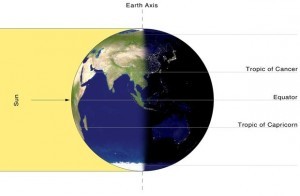The autumn equinox, otherwise know as the first day of fall, arrives on Friday, Sept. 22 in the Earth’s northern hemisphere. The transition marks the time when the sun will be shining directly on the Earth’s equator, bringing equal amounts of daylight and darkness.
Here are 6 things to know about the fall equinox:
(Click to enlarge)
Which is correct – fall, autumn or autumnal equinox?
All three are commonly used and acceptable to refer to the first day of fall. It is sometimes also called the September equinox.
What does equinox mean?
The word equinox was formed by two Latin words: “Equi” is the Latin prefix for “equal” and “nox” is the Latin word for “night.” The equal refers to the fact that the amount of daylight and darkness on this day are nearly equal. There are the technical reasons it is not exactly equal, as explained by TimeAndDate.com.
What about the southern hemisphere?
The fall equinox only arrives on Friday, Sept. 22 for the northern hemisphere of the earth. In the southern hemisphere, Sept. 22 is the vernal or spring equinox.
How is the autumnal equinox celebrated?
In some cultures, the start of autumn is celebrated by feasting on the summer’s harvest and making preparations for the winter. In other cultures, it’s a time to remember and honor the dead “by visiting, cleaning and decorating their graves,” according to a report by TimeAndDate.com.
When is “fall back,” the end daylight saving time?
Daylight saving time does not correspond to the autumnal equinox. Daylight saving time began on March 12 and ends on Sunday, Nov. 5 this year. The winter solstice is Thursday, Dec. 21, marking the first official day of winter in the northern hemisphere.
Is the autumnal equinox significant for weather forecasters?
Not really. Meteorologists don’t follow astronomical seasons and don’t consider Sept. 22 the start of fall. Weather folks consider the first day of autumn to be Sept. 1, the first day of winter Dec. 1, the first day of spring March 1 and the first day of summer June 1. Each of those seasons, known as “meteorological seasons,” runs three full months and they are based on the annual temperature cycle instead of the earth’s rotation around the sun. Here’s a detailed explanation by the National Oceanic and Atmospheric Administration, better known as NOAA.
Source: nj.com

































